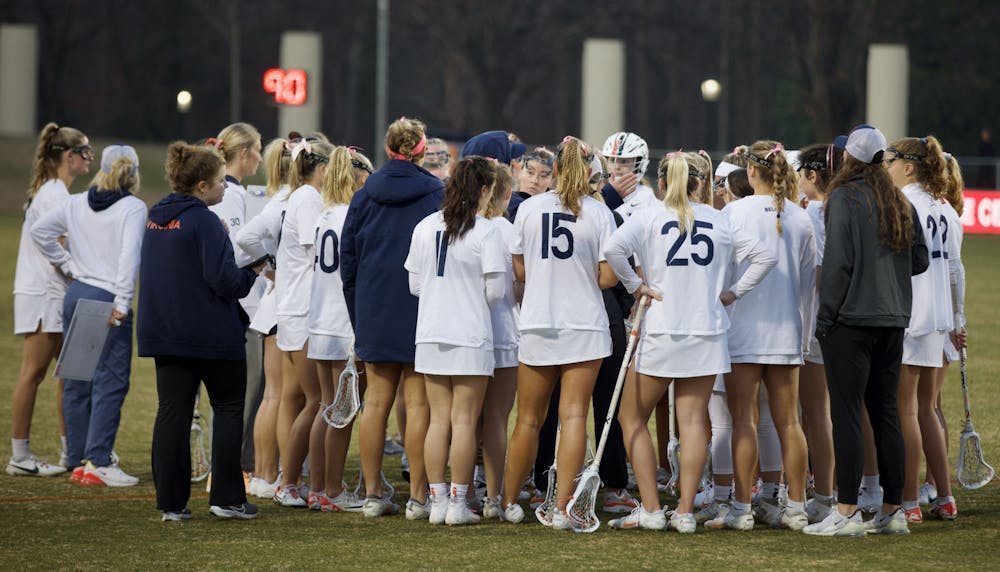The 2024 season for Virginia women’s lacrosse can be described as one of excitement, opportunity and progress. The Cavaliers are looking to rewrite last season’s woes, which saw them lose in the ACC quarterfinals and the first round of the NCAA Tournament.
After losing program stalwart Julie Myers — Virginia’s head coach for 28 years who steered the Cavaliers to a national title and five ACC Championships during her tenure — questions loomed about how well Virginia would perform with newly-appointed Coach Sonia LaMonica at the helm. It didn’t help that the Cavaliers also lost both of their All-ACC First Team attackers in Ashlyn McGovern and junior Rachel Clark heading into the 2024 season, with McGovern graduating and Clark making a surprise transfer to Boston College.
Despite the challenges that Virginia faced coming into the season, LaMonica’s team is defying expectations and appears to be a true contender for not just the ACC Championship, but the national title as well.
What’s gone well?
The Cavaliers have been a force to reckon with on the defensive end this year, ranking fourth in the ACC with 10.09 goals allowed per game. The lynchpin of the defense has been sophomore goalie Mel Josephson, who has been a monster in the goal.
Josephson boasts the best save percentage in the conference, sitting at an incredible 47.1 percent rate. Her shot-stopping work is not the only thing she excels at though, because as a distributor, she consistently makes smart passes to teammates in order to kickstart the subsequent attack. Virginia’s clear percentage sits at 92.2 percent compared to their opponents’ 85.6 percent average when playing against them, giving the Cavaliers a noticeable advantage in transition.
On the attacking end, it would be impossible not to mention senior attacker Morgan Schwab. The senior leads the team in points with 56, and her eye-popping 41 assists currently leads the ACC. In a non-conference game against Richmond, Schwab notched a school record eight assists, adding to her career total that also stands as a school record. Schwab has been instrumental not just in terms of her playmaking ability but also with her leadership as one of the team’s captains. Her play — and her guidance — on the field is a big reason that Virginia has an impressive 9-2 record.
Another bright spot for the Cavaliers this year has been the smooth transition from last year’s lost personnel. As stated before, with McGovern and Clark moving on from the program, there were holes to fill on offense. Graduate attacker Katia Carnevale — a transfer from Lehigh, where she started all 57 games she appeared in for the Mountain Hawks — has slotted in seamlessly with the attack, and leads the team in goals with 34. Additionally, freshman attackers Jenna Dinardo and Madison Alaimo have come up huge for Virginia in their debut seasons — Dinardo is fourth on the team in goals, and Alaimo is tied for third in points.
What can be improved?
This season hasn’t been all highs for the Cavaliers, though. Virginia ranks dead last in the ACC in draw controls. In a game against Stanford, in which the Cavaliers were heavily favored, Virginia came perilously close to defeat and managed to just scrape out a 10-9 win, in part because they were outdrawn by the Cardinal 16-5. Winning the draw is critical because it provides immediate possession, creates scoring opportunities and helps control the flow of the game. It will be hard for Virginia to win games later in the season — especially against the strong opponents the ACC provides — if the draws continue to be a problem.
Furthermore, the turnover battle has not gone the Cavaliers’ way this season either. Virginia ranks in the bottom five in both turnovers and turnovers caused. Taking care of the ball while on offense is essential for any team attempting to take home trophies later this spring.
So, how far can they go?
Virginia has been well-balanced on both sides of the ball for most of the season, and its only two losses have come against tough ACC opponents in No. 8 North Carolina and No. 7 Syracuse, both by a margin of just one goal. Thus, the Cavaliers will enter every game they play with a fighting chance, and big wins against No. 4 Notre Dame and No. 6 James Madison — plus two other victories over ranked opponents — prove that Virginia has what it takes to compete on the national stage.
Although there have been some bumps along the way, the floor for the Cavaliers this year should be an NCAA Tournament appearance — which may be in the bag with only five games remaining — and an appearance in the semifinals of the ACC Tournament. The offensive capabilities of this team will carry them to at least those two checkpoints.
However, things could easily line up for Virginia to make a realistic run farther than merely showing up for the postseason. The Cavaliers are battle-tested, and with some improvements on the turnover margin and draw controls, they will have a great chance at winning the ACC and competing for the National Championship in May. LaMonica has turned Virginia into a fighting force — the question now remains if that force will be enough to bring a trophy to Charlottesville for the first time since 2008.







